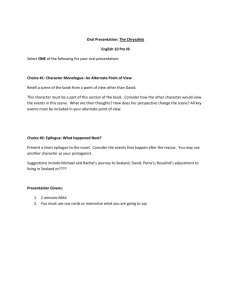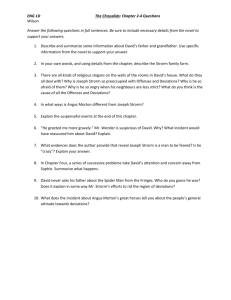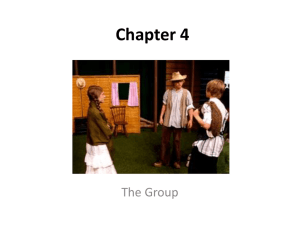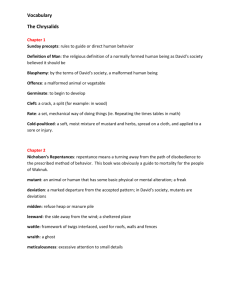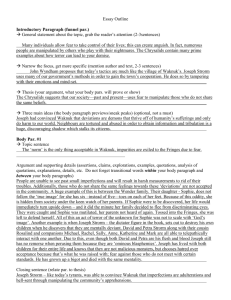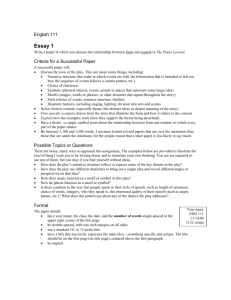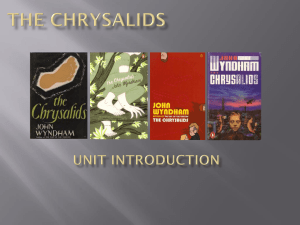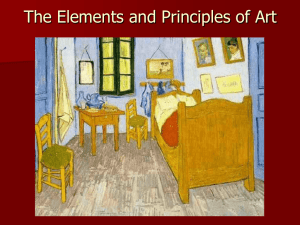Chyrsalids Worksheets updated
advertisement
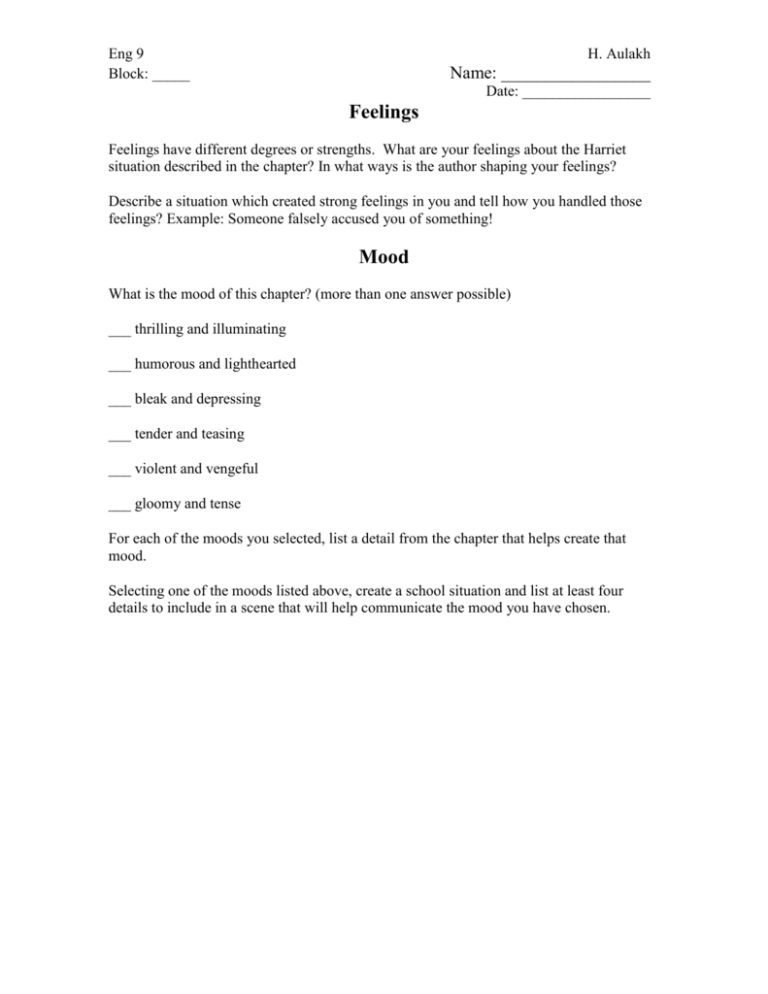
Eng 9 Block: _____ H. Aulakh Name: _________________ Date: _________________ Feelings Feelings have different degrees or strengths. What are your feelings about the Harriet situation described in the chapter? In what ways is the author shaping your feelings? Describe a situation which created strong feelings in you and tell how you handled those feelings? Example: Someone falsely accused you of something! Mood What is the mood of this chapter? (more than one answer possible) ___ thrilling and illuminating ___ humorous and lighthearted ___ bleak and depressing ___ tender and teasing ___ violent and vengeful ___ gloomy and tense For each of the moods you selected, list a detail from the chapter that helps create that mood. Selecting one of the moods listed above, create a school situation and list at least four details to include in a scene that will help communicate the mood you have chosen. Eng 9 Block: _____ H. Aulakh Name: _________________ Date: _________________ CHAPTER 17 Character Reference The author uses a process called characterization to create memorable details about personalities in the novel. This can be done as follows: what the author states directly about the character what the character says and does what others say or think about the character how authors act toward the character Since the story in The Chrysalids is told by David - not the author or an all-knowing narrator - you must rely on the on the last three methods to gain information about characters. Directions Each of the following charts lists some traits possessed by a character in the book. Find several specific pieces of evidence for each trait (from anywhere in the book as you read the text) to prove the character does have that characteristic. Then decide which characterization method (or methods) in each piece of evidence is used to reveal that trait. Check the appropriate column. A. what the character says or thinks B. what the character does C. what others say or think about the character D. how others act toward the character Below you will find an example of a chart for David. In pairs, make a similar chart for each of the following characters in the book: Eng 9 Block: _____ H. Aulakh Name: _________________ Date: _________________ Joseph Strorm - Emily Strorm - Aunt Harriet - Uncle Axel - Spider Man - Rosalind Morton - Anne - Sophie Wender - The Sealand Lady - The Inspector: 1. David Trait curious Evidence How trait is revealed Questions the validity of The Definition of Man. a- says or thinks persistent sensitive brave 2. Joseph Strorm a. narrow-minded b. authoritarian c. hardworking 3. Emily Strorm a. narrow-minded b. compassionate c. pathetic 4. Aunt Harriet a. compassionate b. understanding c. pathetic 5. Uncle Axel a. open-minded b. compassionate c. honest 6. Spider Man a. proud b. narrow-minded c. pathetic 7. Rosalind a. proud b. loving c. sensible 8. Sophie Wender a. proud b. loving c. pathetic 9. The Sealand Lady a. proud b. understanding c. sensible 10. The Inspector a. understanding b. shrewd c. obedient Eng 9 Block: _____ H. Aulakh Name: _________________ Date: _________________ Trait Evidence How trait is revealed Trait Evidence How trait is revealed Eng 9 Block: _____ H. Aulakh Name: _________________ Date: _________________ Chapter 11 Character Connections The Chrysalids has a large cast of CHARACTER BOX characters and they relate to David's life in a number of ways. To distinguish all these characters and understand their relationship to David, a simple visual diagram can be helpful. Directions In each circle below, write the names of at least three characters that fit the label. Pick the names from the character box; some names will be used more than once. David Strorm Rosalind Joseph Strorm Anne Emily Strorm Rachel Petra Strorm Katherine Aunt Harriet Sally Mary Strorm Mark Uncle Axel Sophie Wender Elias Strorm Old Jacob Spider Man Alan Ervin Petra Sealand Lady Michael Jerome Skinner Then answer the questions that follow. The Inspector QUESTIONS: 1. Give an example of a character who serves as both foe and friend to David. Give examples to show the character's hostile and friendly actions. 2. Which characters seem to influence David the most? Why do you that might be so? 3. Which character seems to influence David the least? Why do you think this might be so? 4. Which character seems most admirable to you? Why? 5. Which character seems least admirable to you? Why? 6. Which two groups seem to overlap the most? Why? 7. Which group do you think influences David the most? Why do you think this is so? 8. Which group do you think influences David the least? Why do you think this is so? 9. Which group seems most admirable to you? Why? Eng 9 Block: _____ H. Aulakh Name: _________________ Date: _________________ Eng 9 Block: _____ H. Aulakh Name: _________________ Date: _________________ CHAPTER 12 In this chapter the Group has to deal with possible betrayal and blackmail. It is becoming clear that the Group will be in conflict with the Waknuk society soon. Growing up means meeting a number of challenges and the Group, with the exception perhaps of Michael, has some very fast growing up to do as conflict has become unavoidable. Conflict, or a clash of opposing forces, is a vital part of most novels. Five types of conflict are defined below. character vs. character The character faces a problem with one or more other characters in the story. character vs. self The character faces a physical or emotional problem or struggle character vs. society The character faces a problem with a part, or in this case, the whole of society (government, school, traditions, rules, laws) character vs. nature The character faces a problem with some force of nature (cold, storm, radiation) character vs. fate/ supernatural The character faces a problem with a force such as fate, God, or luck (good or bad) Eng 9 Block: _____ H. Aulakh Name: _________________ Date: _________________ Directions List one conflict that arises in each of the following situations. Some of them may have more than one type of conflict, but you need list only one. After you list the conflict, explain who or what is involved. See the example below. Example David discovers that Sophie Wender has six toes on each foot. a. Conflict: Character vs. Self b. David believes that having six toes is such a little thing, but he is very much aware of the teachings he has received, "Beware thou of the Mutant!" 1. David jokingly wishes he had a third hand and his father and mother overhear him. 2. Uncle Axel tells David to keep quiet about his picture-talking with Rosalind. 3. Sophie Wender has six toes on each foot. 4. Aunt Harriet kills herself and her baby. 5. Anne announces that she going to get married. 6. Members of the Group meet Jerome Skinner. Eng 9 Block: _____ H. Aulakh Name: _________________ Date: _________________ CHAPTER 13 A World of Differences The Chrysalids is told from David's viewpoint. But the various conversations he has with other characters in the story give the reader different views on the same subject. The inclusion of these different views serves two important purposes. First, it allows the reader to get a clearer picture of the other characters and perspectives. Second, the views serve as a force of change. Being exposed to other thoughts help David mature from a naive small boy into a mature young man. Directions Determine what the characters listed feel about each of the following topics. You may use quotes, passages, or inferences (logical conclusions) in your responses. 1. The religion of Waknuk a. David b. Uncle Axel c. Joseph Strorm d. Old Jacob e. The Inspector 2. The Group a. David b. Michael c. Anne d. Joseph Strorm e. Alan Ervin Eng 9 Block: _____ H. Aulakh Name: _________________ Date: _________________ 3. The marriage of Anne a. David b. Michael c. Rachel d. Uncle Axel 4. The Fringes a. David b. Sophie c. Spider Man d. Uncle Axel e. Joseph Strorm 5. The people of Waknuk a. Uncle Axel b. Old Jacob c. the Sealand lady 6. The destruction of the Waknuk posse a. David b. Rosalind c. the Sealand lady Eng 9 Block: _____ H. Aulakh Name: _________________ Date: _________________ CHAPTER 14 Figures in the Round By showing more than one side of a character's personalities, the author makes them seem well rounded or realistic. These realistic portraits are not only a challenge to the author but to the reader. As in dealing with real people, the reader must decide how to merge into one personality many different - even contradictory - traits. Directions Some statements about the personality of the characters in The Chrysalids follow. Give evidence from the book to first support the statement (pro). Then contradict the statement (con). Finally, based on that evidence, draw your own conclusions that explain the character's nature. An example has been done for you. Example: The Inspector upholds the law on deviations. a. Pro: He agrees that Sophie is a mutant b. Con: He approves of Angus big horses c. Your conclusion: He upholds the law only as far as he has to, but is willing to bend when it is convenient. 1. 2. 3. 4. 5. David's mother strictly follows the rules of Waknuk's religion. Rosalind is compassionate. The Sealand woman has high morals. David is cautious. Sophie is caring and unselfish. Eng 9 Block: _____ H. Aulakh Name: _________________ Date: _________________ CHAPTER 15 Links in the Chain One way of tying a story together is through the use of motifs. Motifs are incidents, Images, or ideas which appear again and again in a novel. Like links in a chain, they serve to unite a story. Directions Some motifs in The Chrysalids are listed below. List one example of each of these motifs from the book. Then answer the questions that follow. Motif 1. 2. 3. 4. 5. 6. 7. 8. 9. Death Lack of personal freedom Cruelty Punishment Humiliation Weather conditions Kindness and compassion Jealousy Superstition Questions 1. 2. 3. 4. 5. 6. 7. Mention one way in which motif 3 is linked to motif 5 in the book? Mention one way in which motif 2 is linked to motif 4 in the book? Mention one way in which motif 6 is linked to motif 9 in the book? Mention one way in which motif 4 is linked to motif 7 in the book? Mention one way in which motif 1 is linked to motif 2 in the book? Mention one way in which motif 1 is linked to motif 7 in the book? Mention one way in which motif 3 is linked to motif 9 in the book? Eng 9 Block: _____ H. Aulakh Name: _________________ Date: _________________ CHAPTER 16 Matching Causes and Effects Match each effect (action or decision) with its cause (the reason that something occurs). Each answer may be used only once. Effect 1. Jerome Skinner becomes suspicious of the Group. 2. The crops show more deviations than usual. 3. Uncle Axel puts an arrow on his Cause a. Petra's powers of picture-making are enormous. b. The Sealand people have to detour around the Badlands. c. Beware thou of the Mutant! bow. 4. The Sealand people come to rescue members of the Group. 5. Aunt Harriet kills her baby and herself. 6. Michael does not go to Sealand d. At the end of the story Rachel is all alone in Waknuk. e. David and Rosalind come to the aid of Petra as she is attacked by a wild cat. f. In the past there has been a massive nuclear war. 7. The Spider Man becomes the leader of Fringe people. 8. David and Rosalind hide in a cave in the Fringes. 9. The Sealand people have to detour g. South-Western winds bring radiation to Waknuk. h. Allen Erwin finds out the secret of the Group. i. Sophie loves David. around the Badlands. 10. Not every member of the Group can be rescued. j. Joseph Strorm had a brother who developed a deviation. Eng 9 Block: _____ H. Aulakh Name: _________________ Date: _________________ CHAPTER 17 Pyramid of Action The plot of The Chrysalids is made up of a number of episodes or separate incidents. These incidents are connected in some way so that the plot is tied together. The Chrysalids breaks down into a traditional five-part plot structure. These parts are as follows: exposition - an introduction to the main characters, settings, and situations of the plot rising action - the events and complications that lead to an important and dramatic point in the plot climax - the point of greatest interest and emotional involvement in the plot falling action - the events that develop from the climax and lead to the conclusion resolution or denouement - the final outcome which ties up any loose ends left in the story This structure can be depicted as a lopsided pyramid, with two base lines. Directions Below is a list of major episodes in The Chrysalids. Copy these episodes on a chart in your notebook (similar to the chart found on the next page) in the order in which they occur. After you finish putting the events in proper order, turn the diagram sideways and draw the pyramid diagram (right over your answers in a different colour ink) to reflect where the five elements of the plot occur. Then label the parts of the pyramid. Note: Your pyramid may look lopsided (one side longer than the other). Eng 9 Block: _____ H. Aulakh Name: _________________ Date: _________________ Major Episodes: Petra, through her awesome telepathic powers, gets in touch with a distant civilization in New Zealand (Sealand). David meets Sophie Wender and discovers that she is a physical deviant with six toes on each foot. David sees his aunt driven to suicide because she has given birth to a deviant baby. David, Rosalind, and Petra flee to the Fringes, where they are pursued by the people of Waknuk, including David's own father. The birth of David's little sister, Petra, causes innumerable problems. Under torture Katherine and then Sally admit that David, Rosalind, and Petra also have the ability of mind reading. In the Fringes, David, Rosalind, and Petra are captured by the deviate inhabitants. David, Petra, and Rosalind escape per helicopter to New Zealand. David is concerned for his own personal safety when he realizes that he and his group of E.S.P. friends are also deviants As a child, David has learned the strict morality of his society: "Watch Thou for the Mutant," "The Norm is the Will of God," and "The Devil is the Father of Deviation." Eng 9 Block: _____ H. Aulakh Name: _________________ Date: _________________ Trait Evidence How trait is revealed Trait Evidence How trait is revealed
